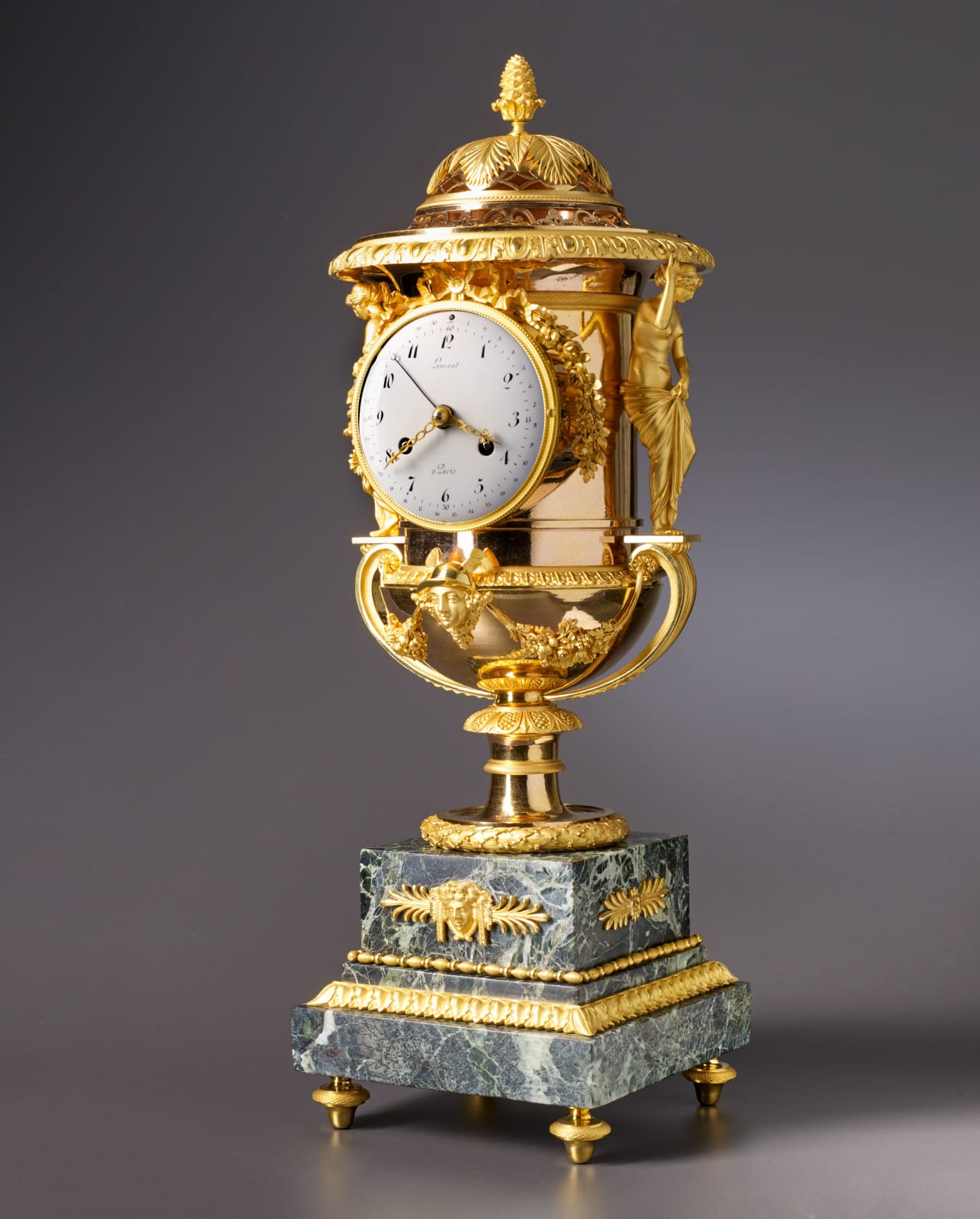
Ernest Dumonthier “Les Bronzes du Mobilier National - Pendules et Cartels”, undated, pl. 53, illustrating a clock of the same model in the Mobilier National.
Laurent
Further images
Literature
Literature: Ernest Dumonthier “Les Bronzes du Mobilier National - Pendules et Cartels”, undated, pl. 53, illustrating a clock of the same model in the Mobilier National.
G. Wannenes, “Le Più Belle Pendole Francesi. Da Luigi XIV all’Impero”, 1991, p. 160, illustrating a clock of the same model.
Pierre Kjellberg, “Encyclopédie de la Pendule Française du Moyen Age au XXe Siècle”, 1997, p. 327, pl. C, illustrating two identical clock cases by Pierre-Philippe Thomire in the Musée François-Duesberg, Mons in Belgium, one dating from the Directoire period signed on the dial Folin l’Aîné à Paris, the other from the Empire period signed on the dial Devillaine à Paris.
Elke Niehüser, “Die Französische Bronzeuhr”, 1997, p.264, pl. 1311, illustrating a clock of an identical model.
A very fine Empire gilt bronze and griotte marble Medici vase-shaped mantel clock of eight day duration by Laurent à Paris housed in a magnificent case attributed to Pierre-Philippe Thomire, signed on the white enamel dial Laurent à Paris, with Roman and Arabic numerals and outer calendar ring numbered 1-31 and a fine pair of pierced gilt brass hands for the hours and minutes and blued steeled pointer for the date indications. The movement with anchor escapement, silk thread suspension, striking on the hour and half hour on a single bell, with outside count wheel. The superb vase-shaped case with a foliate pierced domed cover surmounted by palm fronds and a pinecone finial, the circular bezel headed by a ribbon-tie with cascading floral swags and flanked by a pair of semi-crouched classical female supports standing on plinths above lower scrolled handles, with a Mercury mask below the dial flanked by floral swags above a spreading circular wreath-banded foot placed upon a stepped square griotte marble base centred by an Apollo head mask above beaded and acanthus gilt bronze bands, supported on four turned feet
Paris, date circa 1810
Height 57 cm, base 18 x 18 cm.
This magnificent clock modelled in the form of a Medici vase looks back to the famous Sèvres porcelain model created by the sculptor Louis-Simon Boizet (1743-1809) with mounts supplied by the renowned fondeur-ciseleur Pierre-Philippe Thomire (1751-1843). The latter piece was commissioned by Comte d’Angivillier, surintendant des bâtiments, arts et manufactures and was delivered to Louis XVI and Marie Antoinette at Versailles in 1783. A similar clock was delivered to Château de Fontainebleau on 23rd August 1806, while another comparable example is now housed in the Musée François-Duesberg in Mons, Belgium. Kjellberg cites other identical clocks fitted with movements by the Parisian makers Engaz, Detour and Piolaine.
Given the quality of the bronze work as well as its similarity to other almost identical models, the present case can also be attributed to Pierre-Philippe Thomire. Considered one of history’s finest fondeur-ciseleurs, Thomire enjoyed the patronage of the Emperor Napoleon and his family but also Louis XVI, Louis XVIII as well as foreign monarchy and aristocracy. Born into a family of ciseleurs, Thomire began working with the renowned bronzier Pierre Gouthière (1732-1813) as well as Jean-Louis Prieur (b. 1725 d. after 1785) ciseleur-doreur du roi, before opening up his own workshop in 1776. Famed for his production of finely chased gilt bronze objets de luxe, of which a large quantity was commissioned by the royal household, Thomire frequently collaborated with the marchands-merciers, such as Simon-Philippe Poirier and his successor Dominique Daguerre. In addition, Thomire supplied finely chased mounts to leading ébénistes of his day such as Guillaume Benneman (maître 1785, d. 1811) and Adam Weisweiler (1744-1820). As mentioned above Thomire also worked at the Sèvres Porcelain Manufactory, firstly as an assistant to its artistic director Jean-Claude Duplessis and then following the latter’s death in 1783, he took over Duplessis’s job and in this capacity supplied all the gilt bronze mounts for the factory’s porcelain. His post-Revolutionary success somewhat eclipsed his fame during Louis XVI’s reign and in 1806 he became the first bronzier to be awarded a gold medal at the Exposition des Produits de l’Industrie. He won another gold medal in 1809, in which year he was also appointed ciseleur de l’Empereur.
In response to growing demand Thomire became an associate and then in 1804 purchased the extensive business owned by Martin-Eloi Lignereux, the famous marchand-mercier, formerly associated with Daguerre. Soon his newly named company Thomire-Duterme et Cie was employing a work force of about 800; it had a workshop at rue Boucherat and a showroom at rue Taitbout, from where Thomire retailed a large range of decorative objects inspired by antiquity including clock cases, monumental Greek and Roman style urns and vases as well as surtouts, centrepieces and candelabra. Like many Parisian trades, the firm encountered financial difficulties due Napoleon’s continuing wars. Thus soon after 1815 the partnership with Duterme was dissolved and under its new style, Thomire et Cie thrived once more under the restored Bourbons. 1823 saw Thomire winning a gold medal for sculpture in Paris as well as his retirement from the firm though he continued to produce sculptures and regularly exhibited at the Paris Salon until 1834, after which his business was continued by his two sons-in-law and then by his grandsons up until 1852.
Whilst the exact identity of Laurent à Paris, who made the present movement, is as yet unrecorded, we can safely assume that this is the same Parisian clockmaker who was a member of the jury responsible for deciding matters concerning a new Republican time system in 1794 and was also the same maker of several skeleton clocks showing decimal time. One such example (illustrated in Jean-Dominique Augarde, “Les Ouvriers du Temps”, 1996, p. 340) features superb dials and plaques by the renowned enamel painter Joseph Coteau.




